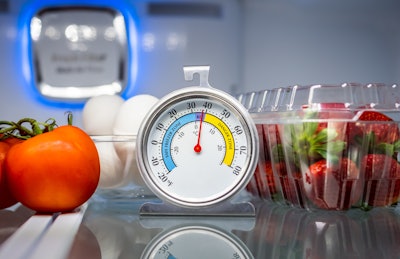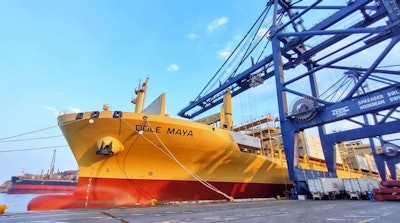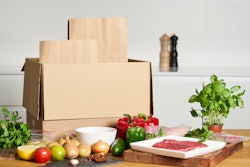
Third-party logistics (3PLs) providers are responsible for a wide range of goods, many shelf-stable but others need to be temperature controlled, which requires more capability, technology and know-how. But, now that a pandemic has changed consumer demand and the grocery industry overall, these factors in cold storage and transportation could look very different in the upcoming year.
As cold storage 3PLs attempt to prepare for 2022, there are numerous things to consider as the Coronavirus disease (COVID-19) pandemic subsides but leaves a wave of change in its wake.
Cold storage grew exceptionally during the pandemic, as home delivery in the grocery space skyrocketed when consumers could no longer shop in stores during severe lockdowns. This powerful demand drove 3PLs closer to the consumer.
“Third-party logistics cold storage saw huge growth during the pandemic specifically to support final-mile deliveries due to the rise in home delivery from grocery stores,” says Sara Cudemo, business development manager, Thermo King Americas. “This was notably different as most cold storage warehouses were more involved upstream of final mile in the cold chain, but intense demand brought them closer to the consumer.”
 The growth in frozen product drives growth in cold storage.Thermo King
The growth in frozen product drives growth in cold storage.Thermo King
If cold storage grew at its traditional pace, the industry would see a 4% increase in 2022. However, due to the change in consumer behavior from the pandemic, the industry could see a jump of 12-15% if online sales continue post pandemic, according to Carel Els, VP of operations, Titan Cold Storage. He says that this potential higher percentage would be due to the underpenetrated e-commerce market.
“This increase is largely due to consumer confidence in online grocery shopping and Amazon’s presence and expansion in the groceries market,” he says. “The forecast prediction is that up to 70% of American households will potentially do some sort of online grocery shopping.
“Every market/industry presents their own challenges and pitfalls, and the cold storage industry is no different. One could easily get blinded by all the upsides, however mistakes are very costly. Likely the two biggest pitfalls in the cold storage industry are the lack of operators and an inefficiently run operation. Cold storage is a niche industry. Always keep an eye on the market demand and beware that the herd mentality can quickly saturate any market.”
Frozen growth
More specifically than the overall growth of cold storage in general is the growth of frozen foods during and post pandemic. According to a study from the American Frozen Food Institute (AFFI), in 2020, frozen food sales saw a 21% jump because of COVID-19 pushing consumers to the frozen food aisle. Additionally, it found that 42% of households buying frozen foods bought those frozen items online, an increase of 23% from 2018. The growth in frozen goods changes the actual temperature ranges that 3PLs need to provide for transportation and storage.
“As the pandemic caused the ‘where’ to shift from restaurants to consumers’ kitchens, it caused a shift in the need for more cold storage of frozen products as more consumers were buying more frozen food than pre-pandemic,” Cudemo says. “While frozen food was a rising trend prior to the pandemic, frozen food enabled consumers to reduce trips to the store or simply stockpile food to feel prepared or because they weren’t used to cooking at home. Whatever the reason, the temperature of the cold storage at facilities changed as a result requiring an increased amount of frozen storage than prior to the pandemic.”
The growth in cold storage and frozen products may continue to grow in the long term, pushing 3PLs to invest more in cold storage facilities and take on other new strategies.
“The increase in home delivery during the pandemic greatly increased the need for more cold storage at warehouses to meet the demand at grocery stores,” Cudemo adds. “It is expected that many consumers may decide to stick with their pandemic grocery ordering habits due to convenience or satisfaction with the process that they may not have previously tried before circumstances changed in 2020. While the world is expected to have a return to normal in 2022, and some rightsizing should occur in home delivery market, I expect to see higher home delivery rates than in 2019 or the baseline pre-pandemic year compared to 2022, which would support a continued need for more cold storage although maybe not the heights of 2020-2021 needs.”
Efficiency is key
Cold storage facility cost is much greater than traditional shelf-stable facilities, but with this increase in demand, 3PLs are investing more money in smaller spaces and looking for ways to drive efficiency, Cudemo says.
Els seconds the need for efficiency, explaining that cold storage facilities are more complicated to construct and plan.
“There is a high demand for newer, more efficient facilities,” he says. “The demand is believed to be up to a 100 million square feet by 2025. Herein comes some of the challenges. It is costly to build and operate cold storage facilities. Build costs are ranging between $250-350 per foot, which is 2-3 times higher than regular industrial construction.
“Additionally, the operating cost is four times higher than regular industrial. Due to the high build and operating costs, investors are faced with a challenge to find operators that are willing to commit to a 15-plus year lease.” Els adds.
To make cold storage facilities more efficient, 3PLs and others in the space look to technology to help, which pushes new tech trends in cold storage in 2022. Portable and flexible cold storage units will become an important part of the 3PL space, according to Cudemo, meaning they can be used for both transportation and fixed storage. The multipurpose units see higher utilization and better return on investment.
 Cold storage reaches overseas travel.Titan Cold
Cold storage reaches overseas travel.Titan Cold
Additionally, cold storage solutions in warehousing that enable up to 1,000 cubic feet of cold storage without needing construction will become prevalent.
Other software such as warehouse management systems (WMS) and terminal operating systems (TOS) that support efficiency in cold storage will be very popular in 2022, says Els.
“Technologies in the cold storage market have mainly two key areas that will impact the bottom line 100%,” he says. “Focus on the cost to operate and operational efficiencies. Due to the high cost of equipment, electrical usage and labor, the operational cost should always be scrutinized and evaluated to ensure the most efficient methods or technology and being used to reduce the operating cost per cubic foot.
“Secondly, there are the efficiencies of the operational activities. WMS’ and TOS’ are large drivers in efficiencies in any warehouse setting whether it be a distribution center or a facility located in a port terminal. You can only improve what you can see, and good systems gives you the visibility to set up measurable KPIs.”
Pitfalls to watch out for
Although growth was prominent throughout the last year, whether or not the growth will continue into 2022 is not known for sure, especially since supply chains have not lived through a pandemic like this in recent, modern times. There might also be this uncertainty, which means 3PLs need to proactively prepare.
“The market could see some rightsizing in certain spaces where needs are contracting, but it may not contract to 2019 baselines as much,” Cudemo says. “It will all depend on consumers’ decisions around grocery delivery, eating out and ordering in. During the pandemic, these behaviors changed so drastically, and we will need to wait and see what the new environment post-pandemic brings for consumer behavior as the return to normal unfolds in 2022.
“While the return to normal is starting to happen in the United States, there is expectation that supply chain issues will still plague many markets into 2022 due to many global supply chains. Companies should plan to proactively source any vital equipment for their businesses, or at the very least plan for long lead times for equipment within their facilities or supply chains,” Cudemo adds.
Another pitfall that will be imperative for 3PLs and other companies in the cold supply chain to pay attention to is cyberattacks. Given the numerous cyberattacks in the supply chain throughout 2021, it is likely there will be more in 2022. For the cold storage sector specifically, hackers may be able to take control of the technology that regulates temperature, looking for a ransom. If the products are out of the necessary temperature range for too long, this will result in spoilage and product loss.
“As technology advances, the threats to our businesses have begun to arise in multiple formats,” says Eric Johnson, VP of Property Damage Appraisers, Inc. “Security risks are on the rise in many industries, and the cold storage industry is not immune. Recently, many cold storage giants have fallen victim to cyberattacks, which have left them vulnerable. Notably, two global biotech firms were hit in late 2020 with malware and cybersecurity incidents. It is critical to your cyberhealth that you are prepared with business continuity plans and strengthened security systems to prevent this from happening to your company.
“Cybersecurity does not just stop with your data,” he continues. “A well-planned attack from a hacker will often involve your facilities and equipment at a deeper level. As an example, you may be subject to a loss of power supply to critical equipment such as digital refrigeration and cooling systems.
“Hackers will calculate the value of your losses and ransom for just enough to ensure a quick payment because they know that an interruption of a certain length will result in a loss that can’t quickly be recovered. They believe that you’ll pay the ransom so as not to fall victim to a slow process in recovering losses from a claim,” says Johnson.
Cybersecurity, shortages, the need for efficiency and fluctuations in consumer demand will dominate the cold storage sector in 2022. These are the things 3PLs need to pay attention to in the coming months as we all prepare for the next year.




















